Veo 3.1 is Google's state-of-the-art model for generating high-fidelity, 8-second 720p or 1080p videos featuring stunning realism and natively generated audio. You can access this model programmatically using the Gemini API. To learn more about the available Veo model variants, see the Model Versions section.
Veo 3.1 excels at a wide range of visual and cinematic styles and introduces several new capabilities:
- Video extension: Extend videos that were previously generated using Veo.
- Frame-specific generation: Generate a video by specifying the first and last frames.
- Image-based direction: Use up to three reference images to guide the content of your generated video.
For more information about writing effective text prompts for video generation, see the Veo prompt guide
Text to video generation
Choose an example to see how to generate a video with dialogue, cinematic realism, or creative animation:
Python
import time
from google import genai
from google.genai import types
client = genai.Client()
prompt = """A close up of two people staring at a cryptic drawing on a wall, torchlight flickering.
A man murmurs, 'This must be it. That's the secret code.' The woman looks at him and whispering excitedly, 'What did you find?'"""
operation = client.models.generate_videos(
model="veo-3.1-generate-preview",
prompt=prompt,
)
# Poll the operation status until the video is ready.
while not operation.done:
print("Waiting for video generation to complete...")
time.sleep(10)
operation = client.operations.get(operation)
# Download the generated video.
generated_video = operation.response.generated_videos[0]
client.files.download(file=generated_video.video)
generated_video.video.save("dialogue_example.mp4")
print("Generated video saved to dialogue_example.mp4")
JavaScript
import { GoogleGenAI } from "@google/genai";
const ai = new GoogleGenAI({});
const prompt = `A close up of two people staring at a cryptic drawing on a wall, torchlight flickering.
A man murmurs, 'This must be it. That's the secret code.' The woman looks at him and whispering excitedly, 'What did you find?'`;
let operation = await ai.models.generateVideos({
model: "veo-3.1-generate-preview",
prompt: prompt,
});
// Poll the operation status until the video is ready.
while (!operation.done) {
console.log("Waiting for video generation to complete...")
await new Promise((resolve) => setTimeout(resolve, 10000));
operation = await ai.operations.getVideosOperation({
operation: operation,
});
}
// Download the generated video.
ai.files.download({
file: operation.response.generatedVideos[0].video,
downloadPath: "dialogue_example.mp4",
});
console.log(`Generated video saved to dialogue_example.mp4`);
Go
package main
import (
"context"
"log"
"os"
"time"
"google.golang.org/genai"
)
func main() {
ctx := context.Background()
client, err := genai.NewClient(ctx, nil)
if err != nil {
log.Fatal(err)
}
prompt := `A close up of two people staring at a cryptic drawing on a wall, torchlight flickering.
A man murmurs, 'This must be it. That's the secret code.' The woman looks at him and whispering excitedly, 'What did you find?'`
operation, _ := client.Models.GenerateVideos(
ctx,
"veo-3.1-generate-preview",
prompt,
nil,
nil,
)
// Poll the operation status until the video is ready.
for !operation.Done {
log.Println("Waiting for video generation to complete...")
time.Sleep(10 * time.Second)
operation, _ = client.Operations.GetVideosOperation(ctx, operation, nil)
}
// Download the generated video.
video := operation.Response.GeneratedVideos[0]
client.Files.Download(ctx, video.Video, nil)
fname := "dialogue_example.mp4"
_ = os.WriteFile(fname, video.Video.VideoBytes, 0644)
log.Printf("Generated video saved to %s\n", fname)
}
REST
# Note: This script uses jq to parse the JSON response.
# GEMINI API Base URL
BASE_URL="https://generativelanguage.googleapis.com/v1beta"
# Send request to generate video and capture the operation name into a variable.
operation_name=$(curl -s "${BASE_URL}/models/veo-3.1-generate-preview:predictLongRunning" \
-H "x-goog-api-key: $GEMINI_API_KEY" \
-H "Content-Type: application/json" \
-X "POST" \
-d '{
"instances": [{
"prompt": "A close up of two people staring at a cryptic drawing on a wall, torchlight flickering. A man murmurs, \"This must be it. That'\''s the secret code.\" The woman looks at him and whispering excitedly, \"What did you find?\""
}
]
}' | jq -r .name)
# Poll the operation status until the video is ready
while true; do
# Get the full JSON status and store it in a variable.
status_response=$(curl -s -H "x-goog-api-key: $GEMINI_API_KEY" "${BASE_URL}/${operation_name}")
# Check the "done" field from the JSON stored in the variable.
is_done=$(echo "${status_response}" | jq .done)
if [ "${is_done}" = "true" ]; then
# Extract the download URI from the final response.
video_uri=$(echo "${status_response}" | jq -r '.response.generateVideoResponse.generatedSamples[0].video.uri')
echo "Downloading video from: ${video_uri}"
# Download the video using the URI and API key and follow redirects.
curl -L -o dialogue_example.mp4 -H "x-goog-api-key: $GEMINI_API_KEY" "${video_uri}"
break
fi
# Wait for 5 seconds before checking again.
sleep 10
done
Image to video generation
The following code demonstrates generating an image using Gemini 2.5 Flash Image aka Nano Banana, then using that image as the starting frame for generating a video with Veo 3.1.
Python
import time
from google import genai
client = genai.Client()
prompt = "Panning wide shot of a calico kitten sleeping in the sunshine"
# Step 1: Generate an image with Nano Banana.
image = client.models.generate_content(
model="gemini-2.5-flash-image",
contents=prompt,
config={"response_modalities":['IMAGE']}
)
# Step 2: Generate video with Veo 3.1 using the image.
operation = client.models.generate_videos(
model="veo-3.1-generate-preview",
prompt=prompt,
image=image.parts[0].as_image(),
)
# Poll the operation status until the video is ready.
while not operation.done:
print("Waiting for video generation to complete...")
time.sleep(10)
operation = client.operations.get(operation)
# Download the video.
video = operation.response.generated_videos[0]
client.files.download(file=video.video)
video.video.save("veo3_with_image_input.mp4")
print("Generated video saved to veo3_with_image_input.mp4")
JavaScript
import { GoogleGenAI } from "@google/genai";
const ai = new GoogleGenAI({});
const prompt = "Panning wide shot of a calico kitten sleeping in the sunshine";
// Step 1: Generate an image with Nano Banana.
const imageResponse = await ai.models.generateContent({
model: "gemini-2.5-flash-image",
prompt: prompt,
});
// Step 2: Generate video with Veo 3.1 using the image.
let operation = await ai.models.generateVideos({
model: "veo-3.1-generate-preview",
prompt: prompt,
image: {
imageBytes: imageResponse.generatedImages[0].image.imageBytes,
mimeType: "image/png",
},
});
// Poll the operation status until the video is ready.
while (!operation.done) {
console.log("Waiting for video generation to complete...")
await new Promise((resolve) => setTimeout(resolve, 10000));
operation = await ai.operations.getVideosOperation({
operation: operation,
});
}
// Download the video.
ai.files.download({
file: operation.response.generatedVideos[0].video,
downloadPath: "veo3_with_image_input.mp4",
});
console.log(`Generated video saved to veo3_with_image_input.mp4`);
Go
package main
import (
"context"
"log"
"os"
"time"
"google.golang.org/genai"
)
func main() {
ctx := context.Background()
client, err := genai.NewClient(ctx, nil)
if err != nil {
log.Fatal(err)
}
prompt := "Panning wide shot of a calico kitten sleeping in the sunshine"
// Step 1: Generate an image with Nano Banana.
imageResponse, err := client.Models.GenerateContent(
ctx,
"gemini-2.5-flash-image",
prompt,
nil, // GenerateImagesConfig
)
if err != nil {
log.Fatal(err)
}
// Step 2: Generate video with Veo 3.1 using the image.
operation, err := client.Models.GenerateVideos(
ctx,
"veo-3.1-generate-preview",
prompt,
imageResponse.GeneratedImages[0].Image,
nil, // GenerateVideosConfig
)
if err != nil {
log.Fatal(err)
}
// Poll the operation status until the video is ready.
for !operation.Done {
log.Println("Waiting for video generation to complete...")
time.Sleep(10 * time.Second)
operation, _ = client.Operations.GetVideosOperation(ctx, operation, nil)
}
// Download the video.
video := operation.Response.GeneratedVideos[0]
client.Files.Download(ctx, video.Video, nil)
fname := "veo3_with_image_input.mp4"
_ = os.WriteFile(fname, video.Video.VideoBytes, 0644)
log.Printf("Generated video saved to %s\n", fname)
}
Using reference images
Veo 3.1 now accepts up to 3 reference images to guide your generated video's content. Provide images of a person, character, or product to preserve the subject's appearance in the output video.
For example, using these three images generated with Nano Banana as references with a well-written prompt creates the following video:
`dress_image` |
`woman_image` |
`glasses_image` |
|---|---|---|

|

|

|
Python
import time
from google import genai
client = genai.Client()
prompt = "The video opens with a medium, eye-level shot of a beautiful woman with dark hair and warm brown eyes. She wears a magnificent, high-fashion flamingo dress with layers of pink and fuchsia feathers, complemented by whimsical pink, heart-shaped sunglasses. She walks with serene confidence through the crystal-clear, shallow turquoise water of a sun-drenched lagoon. The camera slowly pulls back to a medium-wide shot, revealing the breathtaking scene as the dress's long train glides and floats gracefully on the water's surface behind her. The cinematic, dreamlike atmosphere is enhanced by the vibrant colors of the dress against the serene, minimalist landscape, capturing a moment of pure elegance and high-fashion fantasy."
dress_reference = types.VideoGenerationReferenceImage(
image=dress_image, # Generated separately with Nano Banana
reference_type="asset"
)
sunglasses_reference = types.VideoGenerationReferenceImage(
image=glasses_image, # Generated separately with Nano Banana
reference_type="asset"
)
woman_reference = types.VideoGenerationReferenceImage(
image=woman_image, # Generated separately with Nano Banana
reference_type="asset"
)
operation = client.models.generate_videos(
model="veo-3.1-generate-preview",
prompt=prompt,
config=types.GenerateVideosConfig(
reference_images=[dress_reference, glasses_reference, woman_reference],
),
)
# Poll the operation status until the video is ready.
while not operation.done:
print("Waiting for video generation to complete...")
time.sleep(10)
operation = client.operations.get(operation)
# Download the video.
video = operation.response.generated_videos[0]
client.files.download(file=video.video)
video.video.save("veo3.1_with_reference_images.mp4")
print("Generated video saved to veo3.1_with_reference_images.mp4")
Using first and last frames
Veo 3.1 lets you create videos using interpolation, or specifying the first and last frames of the video. For information about writing effective text prompts for video generation, see the Veo prompt guide.
Python
import time
from google import genai
client = genai.Client()
prompt = "A cinematic, haunting video. A ghostly woman with long white hair and a flowing dress swings gently on a rope swing beneath a massive, gnarled tree in a foggy, moonlit clearing. The fog thickens and swirls around her, and she slowly fades away, vanishing completely. The empty swing is left swaying rhythmically on its own in the eerie silence."
operation = client.models.generate_videos(
model="veo-3.1-generate-preview",
prompt=prompt,
image=first_image, # Generated separately with Nano Banana
config=types.GenerateVideosConfig(
last_frame=last_image # Generated separately with Nano Banana
),
)
# Poll the operation status until the video is ready.
while not operation.done:
print("Waiting for video generation to complete...")
time.sleep(10)
operation = client.operations.get(operation)
# Download the video.
video = operation.response.generated_videos[0]
client.files.download(file=video.video)
video.video.save("veo3.1_with_interpolation.mp4")
print("Generated video saved to veo3.1_with_interpolation.mp4")
`first_image` |
`last_image` |
veo3.1_with_interpolation.mp4 |
|---|---|---|

|

|

|
Extending Veo videos
Use Veo 3.1 to extend videos that you previously generated with Veo by 7 seconds and up to 20 times.
Input video limitations:
- Veo-generated videos only up to 141 seconds long.
- Gemini API only supports video extensions for Veo-generated videos.
- The video should come from a previous generation, like
operation.response.generated_videos[0].video - Input videos are expected to have a certain length, aspect ratio, and dimensions:
- Aspect ratio: 9:16 or 16:9
- Resolution: 720p
- Video length: 141 seconds or less
The output of the extension is a single video combining the user input video and the generated extended video for up to 148 seconds of video.
This example takes the a Veo-generated video, shown here with
its original prompt, and extends it using the video parameter and a new
prompt:
| Prompt | Output: butterfly_video |
|---|---|
| An origami butterfly flaps its wings and flies out of the french doors into the garden. |

|
Python
import time
from google import genai
client = genai.Client()
prompt = "Track the butterfly into the garden as it lands on an orange origami flower. A fluffy white puppy runs up and gently pats the flower."
operation = client.models.generate_videos(
model="veo-3.1-generate-preview",
video=operation.response.generated_videos[0].video, # This must be a video from a previous generation
prompt=prompt,
config=types.GenerateVideosConfig(
number_of_videos=1,
resolution="720p"
),
)
# Poll the operation status until the video is ready.
while not operation.done:
print("Waiting for video generation to complete...")
time.sleep(10)
operation = client.operations.get(operation)
# Download the video.
video = operation.response.generated_videos[0]
client.files.download(file=video.video)
video.video.save("veo3.1_extension.mp4")
print("Generated video saved to veo3.1_extension.mp4")
For information about writing effective text prompts for video generation, see the Veo prompt guide.
Handling asynchronous operations
Video generation is a computationally intensive task. When you send a request
to the API, it starts a long-running job and immediately returns an operation
object. You must then poll until the video is ready, which is indicated by the
done status being true.
The core of this process is a polling loop, which periodically checks the job's status.
Python
import time
from google import genai
from google.genai import types
client = genai.Client()
# After starting the job, you get an operation object.
operation = client.models.generate_videos(
model="veo-3.1-generate-preview",
prompt="A cinematic shot of a majestic lion in the savannah.",
)
# Alternatively, you can use operation.name to get the operation.
operation = types.GenerateVideosOperation(name=operation.name)
# This loop checks the job status every 10 seconds.
while not operation.done:
time.sleep(10)
# Refresh the operation object to get the latest status.
operation = client.operations.get(operation)
# Once done, the result is in operation.response.
# ... process and download your video ...
JavaScript
import { GoogleGenAI } from "@google/genai";
const ai = new GoogleGenAI({});
// After starting the job, you get an operation object.
let operation = await ai.models.generateVideos({
model: "veo-3.1-generate-preview",
prompt: "A cinematic shot of a majestic lion in the savannah.",
});
// Alternatively, you can use operation.name to get the operation.
// operation = types.GenerateVideosOperation(name=operation.name)
// This loop checks the job status every 10 seconds.
while (!operation.done) {
await new Promise((resolve) => setTimeout(resolve, 1000));
// Refresh the operation object to get the latest status.
operation = await ai.operations.getVideosOperation({ operation });
}
// Once done, the result is in operation.response.
// ... process and download your video ...
Veo API parameters and specifications
These are the parameters you can set in your API request to control the video generation process.
| Parameter | Description | Veo 3.1 & Veo 3.1 Fast | Veo 3 & Veo 3 Fast | Veo 2 |
|---|---|---|---|---|
prompt |
The text description for the video. Supports audio cues. | string |
string |
string |
negativePrompt |
Text describing what not to include in the video. | string |
string |
string |
image |
An initial image to animate. | Image object |
Image object |
Image object |
lastFrame |
The final image for an interpolation video to transition. Must be used in combination with the image parameter. |
Image object |
Image object |
Image object |
referenceImages |
Up to three images to be used as style and content references. | VideoGenerationReferenceImage object (Veo 3.1 only) |
n/a | n/a |
video |
Video to be used for video extension. | Video object |
n/a | n/a |
aspectRatio |
The video's aspect ratio. | "16:9" (default, 720p & 1080p),"9:16"(720p & 1080p) |
"16:9" (default, 720p & 1080p),"9:16" (720p & 1080p) |
"16:9" (default, 720p),"9:16" (720p) |
resolution |
The video's aspect ratio. | "720p" (default), "1080p" (only supports 8s duration)"720p" only for extension |
"720p" (default), "1080p" (16:9 only) |
Unsupported |
durationSeconds |
Length of the generated video. | "4", "6", "8".Must be "8" when using extension or interpolation (supports both 16:9 and 9:16), and when using referenceImages (only supports 16:9) |
"4", "6", "8" |
"5", "6", "8" |
personGeneration |
Controls the generation of people. (See Limitations for region restrictions) |
Text-to-video & Extension:"allow_all" onlyImage-to-video, Interpolation, & Reference images: "allow_adult" only
|
Text-to-video:"allow_all" onlyImage-to-video: "allow_adult" only
|
Text-to-video: "allow_all", "allow_adult", "dont_allow"
Image-to-video: "allow_adult", and "dont_allow"
|
Note that the seed parameter is also available for Veo 3 models.
It doesn't guarantee determinism, but slightly improves it.
You can customize your video generation by setting parameters in your request.
For example you can specify negativePrompt to guide the model.
Python
import time
from google import genai
from google.genai import types
client = genai.Client()
operation = client.models.generate_videos(
model="veo-3.1-generate-preview",
prompt="A cinematic shot of a majestic lion in the savannah.",
config=types.GenerateVideosConfig(negative_prompt="cartoon, drawing, low quality"),
)
# Poll the operation status until the video is ready.
while not operation.done:
print("Waiting for video generation to complete...")
time.sleep(10)
operation = client.operations.get(operation)
# Download the generated video.
generated_video = operation.response.generated_videos[0]
client.files.download(file=generated_video.video)
generated_video.video.save("parameters_example.mp4")
print("Generated video saved to parameters_example.mp4")
JavaScript
import { GoogleGenAI } from "@google/genai";
const ai = new GoogleGenAI({});
let operation = await ai.models.generateVideos({
model: "veo-3.1-generate-preview",
prompt: "A cinematic shot of a majestic lion in the savannah.",
config: {
aspectRatio: "16:9",
negativePrompt: "cartoon, drawing, low quality"
},
});
// Poll the operation status until the video is ready.
while (!operation.done) {
console.log("Waiting for video generation to complete...")
await new Promise((resolve) => setTimeout(resolve, 10000));
operation = await ai.operations.getVideosOperation({
operation: operation,
});
}
// Download the generated video.
ai.files.download({
file: operation.response.generatedVideos[0].video,
downloadPath: "parameters_example.mp4",
});
console.log(`Generated video saved to parameters_example.mp4`);
Go
package main
import (
"context"
"log"
"os"
"time"
"google.golang.org/genai"
)
func main() {
ctx := context.Background()
client, err := genai.NewClient(ctx, nil)
if err != nil {
log.Fatal(err)
}
videoConfig := &genai.GenerateVideosConfig{
AspectRatio: "16:9",
NegativePrompt: "cartoon, drawing, low quality",
}
operation, _ := client.Models.GenerateVideos(
ctx,
"veo-3.1-generate-preview",
"A cinematic shot of a majestic lion in the savannah.",
nil,
videoConfig,
)
// Poll the operation status until the video is ready.
for !operation.Done {
log.Println("Waiting for video generation to complete...")
time.Sleep(10 * time.Second)
operation, _ = client.Operations.GetVideosOperation(ctx, operation, nil)
}
// Download the generated video.
video := operation.Response.GeneratedVideos[0]
client.Files.Download(ctx, video.Video, nil)
fname := "parameters_example.mp4"
_ = os.WriteFile(fname, video.Video.VideoBytes, 0644)
log.Printf("Generated video saved to %s\n", fname)
}
REST
# Note: This script uses jq to parse the JSON response.
# GEMINI API Base URL
BASE_URL="https://generativelanguage.googleapis.com/v1beta"
# Send request to generate video and capture the operation name into a variable.
operation_name=$(curl -s "${BASE_URL}/models/veo-3.1-generate-preview:predictLongRunning" \
-H "x-goog-api-key: $GEMINI_API_KEY" \
-H "Content-Type: application/json" \
-X "POST" \
-d '{
"instances": [{
"prompt": "A cinematic shot of a majestic lion in the savannah."
}
],
"parameters": {
"aspectRatio": "16:9",
"negativePrompt": "cartoon, drawing, low quality"
}
}' | jq -r .name)
# Poll the operation status until the video is ready
while true; do
# Get the full JSON status and store it in a variable.
status_response=$(curl -s -H "x-goog-api-key: $GEMINI_API_KEY" "${BASE_URL}/${operation_name}")
# Check the "done" field from the JSON stored in the variable.
is_done=$(echo "${status_response}" | jq .done)
if [ "${is_done}" = "true" ]; then
# Extract the download URI from the final response.
video_uri=$(echo "${status_response}" | jq -r '.response.generateVideoResponse.generatedSamples[0].video.uri')
echo "Downloading video from: ${video_uri}"
# Download the video using the URI and API key and follow redirects.
curl -L -o parameters_example.mp4 -H "x-goog-api-key: $GEMINI_API_KEY" "${video_uri}"
break
fi
# Wait for 5 seconds before checking again.
sleep 10
done
Veo prompt guide
This section contains examples of videos you can create using Veo, and shows you how to modify prompts to produce distinct results.
Safety filters
Veo applies safety filters across Gemini to help ensure that generated videos and uploaded photos don't contain offensive content. Prompts that violate our terms and guidelines are blocked.
Prompt writing basics
Good prompts are descriptive and clear. To get the most out of Veo, start with identifying your core idea, refine your idea by adding keywords and modifiers, and incorporate video-specific terminology into your prompts.
The following elements should be included in your prompt:
- Subject: The object, person, animal, or scenery that you want in your video, such as cityscape, nature, vehicles, or puppies.
- Action: What the subject is doing (for example, walking, running, or turning their head).
- Style: Specify creative direction using specific film style keywords, such as sci-fi, horror film, film noir, or animated styles like cartoon.
- Camera positioning and motion: [Optional] Control the camera's location and movement using terms like aerial view, eye-level, top-down shot, dolly shot, or worms eye.
- Composition: [Optional] How the shot is framed, such as wide shot, close-up, single-shot or two-shot.
- Focus and lens effects: [Optional] Use terms like shallow focus, deep focus, soft focus, macro lens, and wide-angle lens to achieve specific visual effects.
- Ambiance: [Optional] How the color and light contribute to the scene, such as blue tones, night, or warm tones.
More tips for writing prompts
- Use descriptive language: Use adjectives and adverbs to paint a clear picture for Veo.
- Enhance the facial details: Specify facial details as a focus of the photo like using the word portrait in the prompt.
For more comprehensive prompting strategies, visit Introduction to prompt design.
Prompting for audio
With Veo 3, you can provide cues for sound effects, ambient noise, and dialogue. The model captures the nuance of these cues to generate a synchronized soundtrack.
- Dialogue: Use quotes for specific speech. (Example: "This must be the key," he murmured.)
- Sound Effects (SFX): Explicitly describe sounds. (Example: tires screeching loudly, engine roaring.)
- Ambient Noise: Describe the environment's soundscape. (Example: A faint, eerie hum resonates in the background.)
These videos demonstrate prompting Veo 3's audio generation with increasing levels of detail.
| Prompt | Generated output |
|---|---|
| More detail (Dialogue and ambience) A wide shot of a misty Pacific Northwest forest. Two exhausted hikers, a man and a woman, push through ferns when the man stops abruptly, staring at a tree. Close-up: Fresh, deep claw marks are gouged into the tree's bark. Man: (Hand on his hunting knife) "That's no ordinary bear." Woman: (Voice tight with fear, scanning the woods) "Then what is it?" A rough bark, snapping twigs, footsteps on the damp earth. A lone bird chirps. |

|
| Less detail (Dialogue) Paper Cut-Out Animation. New Librarian: "Where do you keep the forbidden books?" Old Curator: "We don't. They keep us." |

|
Try out these prompts yourself to hear the audio! Try Veo 3
Prompting with reference images
You can use one or more images as inputs to guide your generated videos, using Veo's image-to-video capabilities. Veo uses the input image as the initial frame. Select an image closest to what you envision as the first scene of your video to animate everyday objects, bring drawings and paintings to life, and add movement and sound to nature scenes.
| Prompt | Generated output |
|---|---|
| Input image (Generated by Nano Banana) A hyperrealistic macro photo of tiny, miniature surfers riding ocean waves inside a rustic stone bathroom sink. A vintage brass faucet is running, creating the perpetual surf. Surreal, whimsical, bright natural lighting. |

|
| Output Video (Generated by Veo 3.1) A surreal, cinematic macro video. Tiny surfers ride perpetual, rolling waves inside a stone bathroom sink. A running vintage brass faucet generates the endless surf. The camera slowly pans across the whimsical, sunlit scene as the miniature figures expertly carve the turquoise water. |

|
Veo 3.1 lets you reference images or ingredients to direct your generated video's content. Provide up to three asset images of a single person, character, or product. Veo preserves the subject's appearance in the output video.
| Prompt | Generated output |
|---|---|
| Reference image (Generated by Nano Banana) A deep sea angler fish lurks in the deep dark water, teeth bared and bait glowing. |

|
| Reference image (Generated by Nano Banana) A pink child's princess costume complete with a wand and tiara, on a plain product background. |

|
| Output Video (Generated by Veo 3.1) Create a silly cartoon version of the fish wearing the costume, swimming and waving the wand around. |

|
Using Veo 3.1, you can also generate videos by specifying the first and last frames of the video.
| Prompt | Generated output |
|---|---|
| First image (Generated by Nano Banana) A high quality photorealistic front image of a ginger cat driving a red convertible racing car on the French riviera coast. |

|
| Last image (Generated by Nano Banana) Show what happens when the car takes off from a cliff. |

|
| Output Video (Generated by Veo 3.1) Optional |

|
This feature gives you precise control over your shot's composition by letting you define the starting and ending frame. Upload an image or use a frame from a previous video generation to make sure your scene begins and concludes exactly as you envision it.
Prompting for extension
To extend your Veo-generated video with Veo 3.1, use the video as an input along with an optional text prompt. Extend finalizes the final second or 24 frames of your video and continues the action.
Note that voice is not able to be effectively extended if it's not present in the last 1 second of video.
| Prompt | Generated output |
|---|---|
| Input video (Generated by Veo 3.1) The paraglider takes off from the top of the mountain and starts gliding down the mountains overlooking the flower covered valleys below. |

|
| Output Video (Generated by Veo 3.1) Extend this video with the paraglider slowly descending. |

|
Example prompts and output
This section presents several prompts, highlighting how descriptive details can elevate the outcome of each video.
Icicles
This video demonstrates how you can use the elements of prompt writing basics in your prompt.
| Prompt | Generated output |
|---|---|
| Close up shot (composition) of melting icicles (subject) on a frozen rock wall (context) with cool blue tones (ambiance), zoomed in (camera motion) maintaining close-up detail of water drips (action). |

|
Man on the phone
These videos demonstrate how you can revise your prompt with increasingly specific details to get Veo to refine the output to your liking.
| Prompt | Generated output |
|---|---|
| Less detail The camera dollies to show a close up of a desperate man in a green trench coat. He's making a call on a rotary-style wall phone with a green neon light. It looks like a movie scene. |

|
| More detail A close-up cinematic shot follows a desperate man in a weathered green trench coat as he dials a rotary phone mounted on a gritty brick wall, bathed in the eerie glow of a green neon sign. The camera dollies in, revealing the tension in his jaw and the desperation etched on his face as he struggles to make the call. The shallow depth of field focuses on his furrowed brow and the black rotary phone, blurring the background into a sea of neon colors and indistinct shadows, creating a sense of urgency and isolation. |

|
Snow leopard
| Prompt | Generated output |
|---|---|
| Simple prompt: A cute creature with snow leopard-like fur is walking in winter forest, 3D cartoon style render. |

|
| Detailed prompt: Create a short 3D animated scene in a joyful cartoon style. A cute creature with snow leopard-like fur, large expressive eyes, and a friendly, rounded form happily prances through a whimsical winter forest. The scene should feature rounded, snow-covered trees, gentle falling snowflakes, and warm sunlight filtering through the branches. The creature's bouncy movements and wide smile should convey pure delight. Aim for an upbeat, heartwarming tone with bright, cheerful colors and playful animation. |

|
Examples by writing elements
These examples show you how to refine your prompts by each basic element.
Subject and context
Specify the main focus (subject) and the background or environment (context).
| Prompt | Generated output |
|---|---|
| An architectural rendering of a white concrete apartment building with flowing organic shapes, seamlessly blending with lush greenery and futuristic elements |

|
| A satellite floating through outer space with the moon and some stars in the background. |

|
Action
Specify what the subject is doing (e.g., walking, running, or turning their head).
| Prompt | Generated output |
|---|---|
| A wide shot of a woman walking along the beach, looking content and relaxed towards the horizon at sunset. |

|
Style
Add keywords to steer the generation toward a specific aesthetic (e.g., surreal, vintage, futuristic, film noir).
| Prompt | Generated output |
|---|---|
| Film noir style, man and woman walk on the street, mystery, cinematic, black and white. |

|
Camera motion and composition
Specify how the camera moves (POV shot, aerial view, tracking drone view) and how the shot is framed (wide shot, close-up, low angle).
| Prompt | Generated output |
|---|---|
| A POV shot from a vintage car driving in the rain, Canada at night, cinematic. |

|
| Extreme close-up of a an eye with city reflected in it. |

|
Ambiance
Color palettes and lighting influence the mood. Try terms like "muted orange warm tones," "natural light," "sunrise," or "cool blue tones."
| Prompt | Generated output |
|---|---|
| A close-up of a girl holding adorable golden retriever puppy in the park, sunlight. |
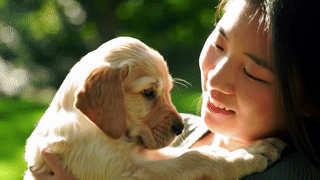
|
| Cinematic close-up shot of a sad woman riding a bus in the rain, cool blue tones, sad mood. |
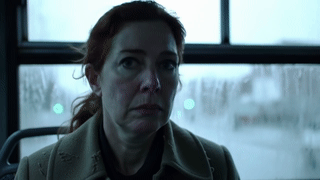
|
Negative prompts
Negative prompts specify elements you don't want in the video.
- ❌ Don't use instructive language like no or don't. (e.g., "No walls").
- ✅ Do describe what you don't want to see. (e.g., "wall, frame").
| Prompt | Generated output |
|---|---|
| Without Negative Prompt: Generate a short, stylized animation of a large, solitary oak tree with leaves blowing vigorously in a strong wind... [truncated] |
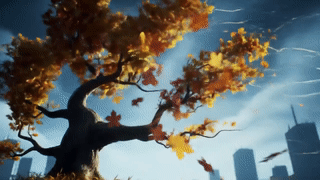
|
| With Negative Prompt: [Same prompt] Negative prompt: urban background, man-made structures, dark, stormy, or threatening atmosphere. |
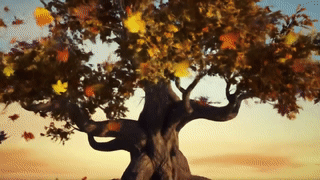
|
Aspect ratios
Veo lets you specify the aspect ratio for your video.
| Prompt | Generated output |
|---|---|
| Widescreen (16:9) Create a video with a tracking drone view of a man driving a red convertible car in Palm Springs, 1970s, warm sunlight, long shadows. |
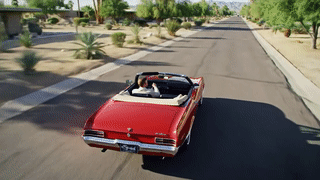
|
| Portrait (9:16) Create a video highlighting the smooth motion of a majestic Hawaiian waterfall within a lush rainforest. Focus on realistic water flow, detailed foliage, and natural lighting to convey tranquility. Capture the rushing water, misty atmosphere, and dappled sunlight filtering through the dense canopy. Use smooth, cinematic camera movements to showcase the waterfall and its surroundings. Aim for a peaceful, realistic tone, transporting the viewer to the serene beauty of the Hawaiian rainforest. |
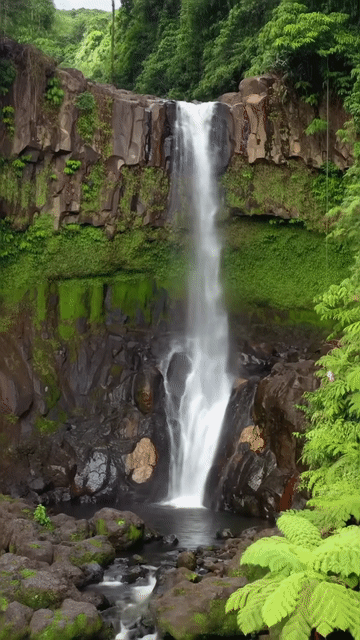
|
Limitations
- Request latency: Min: 11 seconds; Max: 6 minutes (during peak hours).
- Regional limitations: In EU, UK, CH, MENA locations, the following
are the allowed values for
personGeneration:- Veo 3:
allow_adultonly. - Veo 2:
dont_allowandallow_adult. Default isdont_allow.
- Veo 3:
- Video retention: Generated videos are stored on the server for 2 days, after which they are removed. To save a local copy, you must download your video within 2 days of generation. Extended videos are treated as newly generated videos.
- Watermarking: Videos created by Veo are watermarked using SynthID, our tool for watermarking and identifying AI-generated content. Videos can be verified using the SynthID verification platform.
- Safety: Generated videos are passed through safety filters and memorization checking processes that help mitigate privacy, copyright and bias risks.
- Audio error: Veo 3.1 will sometimes block a video from generating because of safety filters or other processing issues with the audio. You will not be charged if your video is blocked from generating.
Model features
| Feature | Description | Veo 3.1 & Veo 3.1 Fast | Veo 3 & Veo 3 Fast | Veo 2 |
|---|---|---|---|---|
| Audio | Natively generates audio with video. | Natively generates audio with video. | ✔️ Always on | ❌ Silent only |
| Input Modalities | The type of input used for generation. | Text-to-Video, Image-to-Video, Video-to-Video | Text-to-Video, Image-to-Video | Text-to-Video, Image-to-Video |
| Resolution | The output resolution of the video. | 720p & 1080p (8s length only) 720p only when using video extension. |
720p & 1080p (16:9 only) | 720p |
| Frame Rate | The output frame rate of the video. | 24fps | 24fps | 24fps |
| Video Duration | Length of the generated video. | 8 seconds, 6 seconds, 4 seconds 8 seconds only when using reference images |
8 seconds | 5-8 seconds |
| Videos per Request | Number of videos generated per request. | 1 | 1 | 1 or 2 |
| Status & Details | Model availability and further details. | Preview | Stable | Stable |
Model versions
Check out the Pricing and Rate limits pages for more Veo model-specific usage details.
Veo Fast versions allow developers to create videos with sound while maintaining high quality and optimizing for speed and business use cases. They're ideal for backend services that programmatically generate ads, tools for rapid A/B testing of creative concepts, or apps that need to quickly produce social media content.
Veo 3.1 Preview
| Property | Description |
|---|---|
| Model code |
Gemini API
|
| Supported data types |
Input Text, Image Output Video with audio |
| Limits |
Text input 1,024 tokens Output video 1 |
| Latest update | September 2025 |
Veo 3.1 Fast Preview
| Property | Description |
|---|---|
| Model code |
Gemini API
|
| Supported data types |
Input Text, Image Output Video with audio |
| Limits |
Text input 1,024 tokens Output video 1 |
| Latest update | September 2025 |
Veo 3
| Property | Description |
|---|---|
| Model code |
Gemini API
|
| Supported data types |
Input Text, Image Output Video with audio |
| Limits |
Text input 1,024 tokens Output video 1 |
| Latest update | July 2025 |
Veo 3 Fast
| Property | Description |
|---|---|
| Model code |
Gemini API
|
| Supported data types |
Input Text, Image Output Video with audio |
| Limits |
Text input 1,024 tokens Output video 1 |
| Latest update | July 2025 |
Veo 2
| Property | Description |
|---|---|
| Model code |
Gemini API
|
| Supported data types |
Input Text, image Output Video |
| Limits |
Text input N/A Image input Any image resolution and aspect ratio up to 20MB file size Output video Up to 2 |
| Latest update | April 2025 |
What's next
- Get started with the Veo 3.1 API by experimenting in the Veo Quickstart Colab and the Veo 3.1 applet.
- Learn how to write even better prompts with our Introduction to prompt design.
